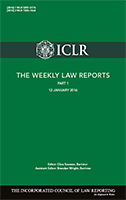Why are cases in the Weekly Law Reports split into separate volumes in the same part?
The explanation is historical.  When launched as a series in 1953, the Weekly Law Reports (WLR) were intended to provide early publication in regular weekly parts of those cases which would eventually appear in the monthly parts of the official Law Reports (AC, Ch, QB or P/Fam volumes). WLR also contained less important cases, covering procedural and practice points, which were listed with an asterisk before the case title. These “starred” cases were confined to volume 1, while the most important cases destined for the Law Reports appeared in volume 2 during the earlier half of the year and in volume 3 during the later half.
When launched as a series in 1953, the Weekly Law Reports (WLR) were intended to provide early publication in regular weekly parts of those cases which would eventually appear in the monthly parts of the official Law Reports (AC, Ch, QB or P/Fam volumes). WLR also contained less important cases, covering procedural and practice points, which were listed with an asterisk before the case title. These “starred” cases were confined to volume 1, while the most important cases destined for the Law Reports appeared in volume 2 during the earlier half of the year and in volume 3 during the later half.
This meant that at the end of the year, when the paper parts were bound into volumes, each weekly part could be divided into two sections. The volume 1 cases could be bound up sequentially into that volume. The volume 2 and 3 cases could either be separately bound into their own volumes, or they could simply be discarded on the basis that, once those same cases had appeared in the Law Reports, they would no longer be needed in their WLR edition.
In the early years the number of cases was relatively small and the cases themselves were relatively short; but in recent years judgments have got longer and more of them have been reported, particularly in volume 1 of WLR. That ‘volume’ has often appeared in two or three separate books by reason of the amount of material.
ICLR eventually resolved to add a fourth volume, from 2016, which would not be printed but would merely appear online, as an extension to the existing content. The cases in volume 4 include those that illustrate the application of existing principles to particular factual situations or helpfully bring together and summarise established principles, as well as providing deeper coverage of family law, shipping, sentencing and awards of general damages.
Although the WLR paper parts do not include volume 4 cases, they are included in the online subscriptions to ICLR.4, as well as via services such as LexisNexis and Westlaw.
You can browse all the cases in WLR over the years via our Browse function on ICLR.4
Related Knowledge
- Guide to ICLR law reports and their citations Guides
- Anatomy of a law report Case Law
Related Posts
- 1953: A year to remember News & Events
